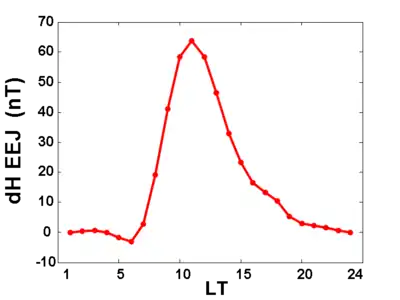
The equatorial electrojet (EEJ) is a narrow ribbon of current flowing eastward in the day time equatorial region of the Earth's ionosphere. The abnormally large amplitude of variations in the horizontal components measured at equatorial geomagnetic observatories, as a result of EEJ, was noticed as early as 1920 from Huancayo geomagnetic observatory. Observations by radar, rockets, satellites, and geomagnetic observatories are used to study EEJ.
Causes
The explanation[1] for the existence of the equatorial electrojet lies with the anisotropic nature of ionospheric electrical conductivity and a process of self-reinforcement. Global-scale ionospheric circulation establishes a Sq (solar quiet) current system in the E region of the Earth's ionosphere (100–130 km altitude), and a primary eastwards electric field near day-side magnetic equator, where the magnetic field is horizontal and northwards. This electric field gives a primary eastwards Pedersen current. E cross B drift results in a downwards Hall current, sustaining vertical charge separation across the depth of the ionosphere, giving an upwards secondary electric field and a secondary Pedersen current that is opposite to the primary Hall current. A secondary Hall current then reinforces the original Pedersen current. At about 110 km height, the integration of the current density gives a peak current strength of about 100 kA, which supports a day-side electrojet magnetic-field enhancement of a factor of two or so.
Lunar Tide
As the position of the sun, moon, and earth changes, so does the strength of the lunar tidal forces. Each lunar month, two spring tides occur when the sun, moon, and earth are aligned to produce a strong lunar tidal force. Likewise, two neap tides occur when the sun and moon are adjacent to one another to produce weak lunar tidal forces. The equatorial electrojet (EEJ) has an abnormally large amplitude of variations in the horizontal components due to the strength of the lunar tides. The lunar tide varies as described above and is changed by the gravitational attraction between the Moon and Earth. Because of this, the pressure and temperature of the lower atmosphere vary, and the effects propagate upward in a tidal wave form to the E region and modulate the electrodynamics.
Studies of the EEJ from satellite and ground magnetic data
The EEJ phenomenon was first identified using geomagnetic data. The amplitude of the daily variation of the horizontal magnetic intensity (ΔH) measured at a geomagnetic observatory near the dip-equator is 3–5 fold higher than the variation of data from other regions of Earth. A typical diurnal equatorial observatory data show a peak of strength ~80 nT at 12:00 LT, with respect to the night-time level. Egedal (1947) showed that the enhancement of quiet day solar daily variations in ΔH (Sq(H)) lay within the 50 latitude centered on the dip equator. The mechanism that produced the variation in the magnetic field was proposed as a band of current about 300 km in width flowing over the dip equator.
EEJ studies from satellite data were initiated with the arrival of data from the POGO (Polar Orbiting Geophysical Observatories) series of satellite (1967–1970). The characteristic signature of the EEJ is a sharp negative V-shaped curve in the H field, attaining its minimum within 0.5° of the magnetic dip equator. The magnetic data from satellite missions like Ørsted (1999–present) and CHAMP (2000–present) have vastly improved our knowledge of the EEJ.
Recent studies have focused on the lunar-solar interaction is the EEJ. It was demonstrated that complexity is introduced into the EEJ due to the interaction between lunar tide variability in the equatorial electric field and solar-driven variability in the E-region conductivity. [2]

References
- Egedal, J. 1947. The magnetic diurnal variation of the horizontal force near the magnetic equator. Terr. Magn. Atmos. Electr. 52, 449 – 451
- Chapman, S. 1951, The equatorial electrojet as detected from the abnormal electric current distribution above Huancayo, Peru, and elsewhere. Arch. Met. Geoph. Biokl. A. 4, 368–390
- Sabaka, T., N. Olsen, and M. Purucker (2004) Extending Comprehensive Models of the Earth's Magnetic Field with Oersted and CHAMP data, Geophys. J. Int.,159, 521-547.
- Gasperini, F., J. Forbes (2014) Lunar-Solar Interactions in the Equatorial Electrojet, Geophys. Res. Lett., doi: 10.1002/2014GL059294.
- J. J. Love (February 2008). "Magnetic monitoring of Earth and space" (PDF). Physics Today. Archived from the original (PDF) on 2008-07-05.
- The Equatorial Electrojet By C. Agodi Onwumechili, Published 1997 CRC Press, ISBN 90-5699-069-1, https://books.google.com/books?id=kwCFPH4C3tEC
- Sabaka, T., N. Olsen, and M. Purucker (2004) Extending Comprehensive Models of the Earth's Magnetic Field with Oersted and CHAMP data, Geophys. J. Int.,159, 521-547.
- ↑ Baker, W. G.; Martyn, D. F. (1953). "Electric currents in the ionosphere I. The conductivity". Phil. Trans. R. Soc. Lond. A. 246 (913): 281–294. Bibcode:1953RSPTA.246..281B. doi:10.1098/rsta.1953.0016. S2CID 122158550.
- ↑ Gasperini, F.; Forbes, J. M. (February 2014). "Lunar-Solar Interactions in the Equatorial Electrojet". Geophysical Research Letters. 41 (9): 3026–3031. Bibcode:2014GeoRL..41.3026G. doi:10.1002/2014GL059294.